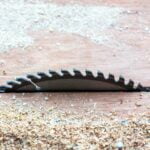Introduction
Removing dried latex paint from woodwork or other surfaces can be a difficult and frustrating task. Many people make the mistake of trying to remove paint quickly and aggressively, leading to further damage to the surface or underlying material. To ensure you are able to remove dried paint in an effective way without damaging the wood, it is important to employ best practices.
When seeking to remove dried latex paint, invest in a quality paint scraper or stripper. Ensure it’s sharp so you can easily scrape away the paint without putting too much force on the wood underneath’which can cause gouges or chips in the wood. Start by slowly and gently scraping away at the dried paint, while keeping your scraper almost flat against the surface. If needed, you can lightly touch up any rough-edged spots with sandpaper after removing all of the painted coatings.
If scraping alone doesn’t work well enough, consider using a chemical stripper that contains methylene chloride for tougher dry painted surfaces. Be sure to follow directions closely and use in a properly ventilated space with plenty of protective coverings such as gloves and eyewear. Additionally, give yourself enough time for the product to do its job”allowing it to sit overnight is often necessary if working with thick layers of latex paint. Last but not least, always end your removal process with thorough cleaning and drying before applying new finishes or refinishing projects!
Safety Precautions
Supplies and Tools Needed:
1. Latex Paint Remover – Choose a latex paint remover specifically designed to remove dried paint from woodwork. Read and follow the instructions on the label of the product before use.
2. Plastic Scraper or Putty Knife – Use a plastic scraper or putty knife with a flexible blade when removing paint to avoid damaging the underlying woodwork. Be careful not to gouge or scratch the surface of the woodwork.
3. Steel Wool ” Steel wool can be used for specific areas to help loosen dried paint before applying latex paint remover. Use steel wool that is labeled “000” so it doesn’t leave any scratches or marks behind on the surface of the woodwork when cleaning.
Instructions:
1. Start by using steel wool (000 grade) gently rubbing any areas where there is dried Latex Paint on your woodwork in order to help break it up and allow for easier removal with other tools/products mentioned beneath this list of supplies and tools needed above.
2. Ensure you are wearing safety glasses and gloves before starting; then prepare your work area, wiping down surfaces as needed, laying out drops cloths, moving furniture away from walls, etc., as required prior beginning to working in this space following these instructions below to safely clean up this dried latex paint spill once you have already tested an at-home method of removal on an inconspicuous area first in order to ensure no damage will occur prior attempting these simple remedies mentioned here today on any visible surface areas around your home:
3. Apply an appropriate amount of Latex Paint Remover according to product instructions and purity levels indicated upon product packaging over any remaining/lingering dried up latex paint”this should also be done outside, particularly if selecting a solvent-based options instead”using a plastic scraper or putty knife (if needed) before wiping off excess residue left after waiting 10-15 minutes allowing time for remover(s) indicated within product labelling guidelines, depending upon which option has been chosen for your particular desired application within this process at hand today, do not let product sit overnight without further cleaning before proceeding onto next steps listed here now; moreover 0 ” begin slowly scraping off softened layers of original substance until all traces are completely gone being sure not worry delicate surfaces being treated here today in possible process while protecting underlying finish whenever possible during handling precautions outline herein prior attempting any other DIY go-to methods outlined during stage two describe just above:
4. Once complete wipe down surfaces cleaned with mild soapy water solution combining detergent free formula partnered alongside lint free cloths wrung out well beforehand or paper towels may substitute advice includes rinsing area often exchanging dirty washcloths/towels found throughout process ending rinse but one last times then drying thoroughly completing job overall
Preparing Your Work Area
To remove dried latex paint from woodwork, first determine what type of wood you are working with. Some surfaces may require a different approach than others and it is important to protect the wood before beginning. Depending on the size of the area or project, it may be best to cover the surface with drop cloths and set up a workspace away from pets and children. Be sure to wear protective clothing when handling solvents, abrasives or power tools as these products can be dangerous and harsh on skin.
Removing Latex Paint
There are a number of different types of paint removers that can be used to remove dried latex paint from woodwork – including heat guns, chemical paint strippers, and sanding.
For areas with intricate details or where there are contact restrictions due to age (such as antique pieces), using a heat gun is often the best choice. Heat guns provide efficient targeted heat which will soften and break down the bonds in the paint allowing it to be scraped away. Heat guns should never be used on lead-based or other hazardous paints as they involve extreme temperatures which may cause further damage and release toxic fumes.
Chemical strippers are very effective in removing various types and layers of paint, but can produce noxious fumes and must be applied in a well-ventilated area while wearing protective gear such as gloves, goggles and a respirator mask. When choosing a chemical stripper, ensure that it is safe for use on woodwork ” there are many different formulas available depending on what type of finish you have. As you apply the stripper, let it sit for several minutes before scraping/scrubbing away the loosened finish.
Finally, sanding is an effective way to remove soft latex finishes from woodwork; however, this process requires more elbow grease than any other method mentioned above! Sandpaper comes in various grits so that you can ensure your surface isn’t scratched too much ” if you’re working with detailed work or varnished surfaces then start with higher grits before graduation to finer grits (as dictated by how worn your paint might be). Once complete, thoroughly vacuum off all dust particles and apply necessary finishing materials such as primer/paint or stain/varnish.
Cleaning and Resetting
When selecting a sealer or finish to protect the woodwork from future damage, it is important to consider the type of paint used. Water-based paints are generally easier to remove than oil-based paints. It might be helpful to test a small area first before attempting to remove the dried paint from a larger surface.
Once the choice of sealers or finishes has been made, proper application is critical for effective protection. In most cases, you will want to use two coats”the first to make sure all areas are covered, and the second one should intersect with the previous coat at an angle so as not to miss any spots. A good brush will also help with even coverage, and in many cases using a roller ensures more uniform application while helping with maneuverability in hard-to-reach areas like corners and edges.
Before applying either coat it is important to make sure that the surface has been fully cleaned and prepped before continuing; use a cleaner specifically designed for cleaning latex paint and any tools or supplies listed by its manufacturer for use on woodwork surfaces. Special attention should be paid when working near trim pieces, removes any excess residue from grooves or ridges prior to painting; otherwise these areas can become very difficult if not impossible to clean after application of the finish.
Conclusion
Resource Section:
1. How to Remove Dried Latex Paint from Woodwork – https://www.hunker.com/13416074/removing-dried-latex-paint-from-woodwork
2. How to Remove Latex Paint from Surfaces – https://www.lowes.com/projects/paint-stain-and-wallpaper/remove-latex-paint/project
3. The Best Way to Remove Latex Paint from Wood – https://doityourself.com/stry/bestwaytoremovlatexpaintfromwood
4. Goof Off Pro Strength multi purpose Remover – https://www.walmart.com/ip/Goof-Off-ProStrength-MultiPurposeRemover32oz/661992573
5. Goo Gone 8 oz Liquid Surface Safe Adhesive Remover – https://amzn.to/3bpab5Q

Hi everyone! I’m a woodworker and blogger, and this is my woodworking blog. In my blog, I share tips and tricks for woodworkers of all skill levels, as well as project ideas that you can try yourself.





